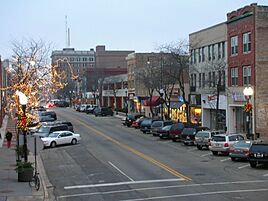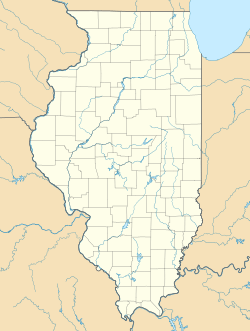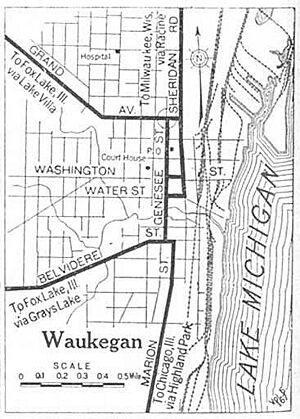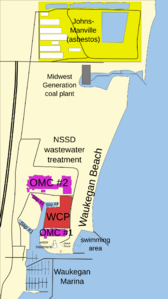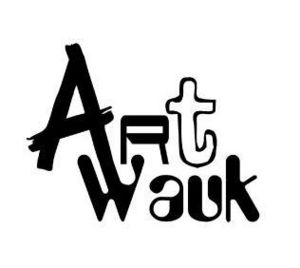Waukegan, Illinois facts for kids
Quick facts for kids
Waukegan, Illinois
|
||
|---|---|---|
|
Downtown Waukegan
Genesee Theatre
Waukegan Harbor Lighthouse
|
||
|
||
| Nickname(s):
WaukTown, Green Town
|
||
| Motto(s):
An Illinois Arts-Friendly Community
|
||
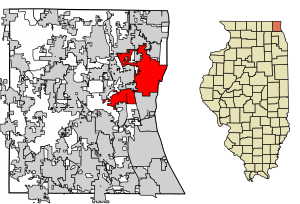
Location of Waukegan in Lake County, Illinois.
|
||
| Country | United States | |
| State | Illinois | |
| Counties | Lake | |
| Founded | 1829 | |
| Incorporated (town) | March 31, 1849 | |
| Incorporated (city) | February 23, 1859 | |
| Named for | Potawatomi: Wakaigin (Fortress or Trading Post) |
|
| Government | ||
| • Type | Mayor–council | |
| Area | ||
| • City | 24.47 sq mi (63.38 km2) | |
| • Land | 24.22 sq mi (62.72 km2) | |
| • Water | 0.26 sq mi (0.66 km2) 0.99% | |
| Elevation | 715 ft (218 m) | |
| Population
(2020)
|
||
| • City | 89,321 | |
| • Rank | 10th largest in Illinois 390th largest in U.S. |
|
| • Density | 3,688.36/sq mi (1,424.06/km2) | |
| • Metro | 9,472,676 | |
| Demonym(s) | Waukeganite | |
| Time zone | UTC−6 (CST) | |
| • Summer (DST) | UTC−5 (CDT) | |
| ZIP Codes |
60079, 60085, 60087
|
|
| Area code(s) | 847 & 224 | |
| FIPS code | 17-79293 | |
| U.S. Routes | ||
| Major State Routes | ||
| Waterways | Waukegan River | |
| Airports | Waukegan National Airport | |
Waukegan (/wəˈkiːɡən/ wə-KEE-ghən) is the most populous city in and county seat of Lake County, Illinois, United States. Located 36 miles (58 km) north of Chicago, Waukegan is a satellite city within the greater Chicagoland area. As of the 2020 census, its population was 89,321, making it the seventh-most populous city within the Chicago metropolitan area and the 10th-most populous city in Illinois.
Unlike nearby wealthy North Shore suburbs, Waukegan has long been classified by the Illinois state government as overall "socioeconomically distressed" despite having some middle class inhabitants.
Contents
History
Founding and 19th century
The site of present-day Waukegan was recorded as Rivière du Vieux Fort ("Old Fort River") and Wakaygagh on a 1778 map by Thomas Hutchins. By the 1820s, the French name had become "Small Fort River" in English, and the settlement was known as "Little Fort". The name "Waukegance" and then "Waukegan" (meaning "little fort"; cf. Potawatomi wakaigin "fort" or "fortress") was created by John H. Kinzie and Solomon Juneau, and the new name was adopted on March 31, 1849.
Waukegan had an abolitionist community dating to these early days. In 1853, residents commemorated the anniversary of emancipation of slaves in the British Empire with a meeting. Waukegan arguably has the distinction of being the only place where Abraham Lincoln failed to finish a speech. When he was campaigning in the town in 1860, he was interrupted by a ringing fire alarm.
During the middle of the 19th century, Waukegan was becoming an important industrial hub. Industries included ship and wagon building, flour milling, sheep raising, pork packing, and dairying. William Besley's Waukegan Brewing Company was one of the most successful of these businesses, being able to sell beyond America. The construction of the Chicago and Milwaukee Railway through Waukegan by 1855 stimulated the growth and rapid transformation and development of the city's industry, so much that nearly 1000 ships were visiting Waukegan harbor every year. During the 1860s, a substantial German population began to grow inside the city.
Waukegan's development began in many ways with the arrival of industries such as United States Sugar Refinery, which opened in 1890, Washburn & Moen, a barbed-wire manufacturer that prompted both labor migration and land speculation beginning in 1891, U.S. Starch Works, and Thomas Brass and Iron Works. Immigrants followed, mostly from southeastern Europe and Scandinavia, with especially large groups from Sweden, Finland, and Lithuania. The town also became home to a considerable Armenian population. One member of this community, Monoog Curezhin, even became embroiled in an aborted plot to assassinate Sultan Abdul Hamid II, reviled for his involvement in massacres of Armenians in the Ottoman Empire. Curezhin lost two fingers on his right hand while testing explosives for this purpose in Waukegan in 1904.
20th century
By the 1920s and 1930s, African Americans began to migrate to the city, mostly from the South. The town was afflicted with racial strife. In June 1920, an African-American boy allegedly hit the car of an off-duty sailor from nearby Great Lakes Naval Base with a rock, and hundreds of white sailors gathered at Sherman House, a hotel reserved for African Americans. Although newspaper reports and rumors suggested that the officer's wife was hit with glass from the broken windshield, subsequent reports revealed that the officer was not married. The sailors called for lynchings, but were kept back by the intervention of the police.
Marines and sailors renewed their attack on the hotel several days later. The Sherman House residents fled for their lives as the military members carried torches, gasoline, and the American flag. The Waukegan police once again turned them away, but not before firing and wounding two members of the crowd. The police were not always so willing to protect Waukegan's citizens. The chief of police and the state's attorney in the 1920s, for example, were avowed members of the Ku Klux Klan, facts that came to light when a wrongfully convicted African-American war veteran was released from prison on appeal after 25 years. Labor unrest also occurred regularly. In 1919, a strike at the US Steel and Wire Company – which had acquired Washburn & Moen – led to a call for intervention from the state militia.
Noted organized crime boss Johnny Torrio served time in Waukegan's Lake County jail in 1925. He installed bulletproof covers on the windows of his cell at his own expense for fear of assassination attempts.
The Waukegan urban area developed independently of Chicago, before being officially incorporated into the Chicago metropolitan area during the 2000 census. This inclusion took place as a result of suburban sprawl, effectively dissolving the region's identity as self-standing. Despite this, Waukegan has retained a distinct industrial character in contrast to many of the residential suburbs along Chicago's North Shore. The financial disparity created by the disappearance of manufacturing from the city in part contributed to the Waukegan riot of 1966. Central to this event and the remainder of Waukegan's 20th-century history was Robert Sabonjian, who served as mayor for 24 years, and earned the nickname the "Mayor Daley of Waukegan" for his personal and sometimes controversial style of politics.
Geography
Waukegan is located at 42°22′13″N 87°52′16″W / 42.37028°N 87.87111°W (42.3703140, −87.8711404). Waukegan is on the shore of Lake Michigan, about 11 miles (18 km) south of the border with Wisconsin and 37 miles (60 km) north of downtown Chicago at an elevation around 650 feet (200 m) above sea level. Chicago has two major streets that venture north to Waukegan, one being Sheridan Road, which extends north from Diversey Parkway in Lincoln Park. The second street is Milwaukee Avenue, which starts at the intersection of Desplaines Street and Kinzie Street in downtown Chicago.
According to the 2010 census, Waukegan has a total area of 24.50 square miles (63.45 km2), of which 0.24 square miles (0.62 km2), or 0.99%, is covered by water.
Major streets
 Skokie Highway
Skokie Highway Waukegan Road
Waukegan Road Belvidere Road
Belvidere Road Green Bay Road
Green Bay Road Grand Avenue
Grand Avenue Sheridan Road/Amstutz Expressway
Sheridan Road/Amstutz Expressway- Lewis Avenue
- Washington Street
- Genesee Street
Climate
Waukegan is located within the humid continental climate zone (Köppen: Dfa) with warm to hot (and often humid) summers, and cold and snowy winters. The record high temperature is 108 °F (42 °C), which was set in July 1934, while the record low is −27 °F (−33 °C), set in January 1985. Waukegan's proximity to Lake Michigan helps cool the city throughout the year.
| Climate data for Waukegan, IL (1981–2010 normals) | |||||||||||||
|---|---|---|---|---|---|---|---|---|---|---|---|---|---|
| Month | Jan | Feb | Mar | Apr | May | Jun | Jul | Aug | Sep | Oct | Nov | Dec | Year |
| Record high °F (°C) | 64 (18) |
71 (22) |
83 (28) |
92 (33) |
95 (35) |
105 (41) |
108 (42) |
102 (39) |
103 (39) |
90 (32) |
80 (27) |
69 (21) |
108 (42) |
| Mean maximum °F (°C) | 48 (9) |
51 (11) |
67 (19) |
80 (27) |
86 (30) |
92 (33) |
95 (35) |
93 (34) |
90 (32) |
81 (27) |
67 (19) |
53 (12) |
96 (36) |
| Mean daily maximum °F (°C) | 29.9 (−1.2) |
34.1 (1.2) |
44.0 (6.7) |
55.9 (13.3) |
66.5 (19.2) |
77.0 (25.0) |
81.4 (27.4) |
80.0 (26.7) |
73.0 (22.8) |
61.0 (16.1) |
47.5 (8.6) |
34.2 (1.2) |
57.0 (13.9) |
| Daily mean °F (°C) | 22.5 (−5.3) |
26.5 (−3.1) |
35.9 (2.2) |
46.9 (8.3) |
56.8 (13.8) |
67.0 (19.4) |
72.3 (22.4) |
71.3 (21.8) |
63.4 (17.4) |
51.6 (10.9) |
39.8 (4.3) |
27.3 (−2.6) |
48.4 (9.1) |
| Mean daily minimum °F (°C) | 15.1 (−9.4) |
18.9 (−7.3) |
27.8 (−2.3) |
37.8 (3.2) |
47.0 (8.3) |
57.1 (13.9) |
63.2 (17.3) |
62.7 (17.1) |
53.8 (12.1) |
42.3 (5.7) |
32.1 (0.1) |
20.4 (−6.4) |
39.9 (4.4) |
| Mean minimum °F (°C) | −9 (−23) |
−3 (−19) |
8 (−13) |
23 (−5) |
32 (0) |
42 (6) |
49 (9) |
49 (9) |
38 (3) |
27 (−3) |
13 (−11) |
−2 (−19) |
−12 (−24) |
| Record low °F (°C) | −27 (−33) |
−24 (−31) |
−12 (−24) |
8 (−13) |
24 (−4) |
32 (0) |
41 (5) |
40 (4) |
27 (−3) |
11 (−12) |
−5 (−21) |
−23 (−31) |
−27 (−33) |
| Average precipitation inches (mm) | 1.69 (43) |
1.31 (33) |
2.25 (57) |
3.37 (86) |
3.37 (86) |
3.79 (96) |
3.29 (84) |
3.51 (89) |
3.43 (87) |
2.51 (64) |
2.43 (62) |
1.82 (46) |
32.31 (821) |
| Average snowfall inches (cm) | 10.8 (27) |
8.4 (21) |
6.4 (16) |
1.4 (3.6) |
0.0 (0.0) |
0.0 (0.0) |
0.0 (0.0) |
0.0 (0.0) |
0.0 (0.0) |
0.1 (0.25) |
2.0 (5.1) |
8.4 (21) |
36.4 (92) |
Superfund sites
Waukegan contains three Superfund sites of hazardous substances that are on the National Priorities List.
In 1975, PCBs were discovered in Waukegan Harbor sediments. Investigation revealed that during manufacturing activities at Outboard Marine Corporation (OMC), hydraulic fluids containing PCBs had been discharged through floor drains at the OMC plant, directly to Waukegan Harbor and into ditches discharging into Lake Michigan. The OMC plants were subsequently added to the National Priorities List, and was designated as one of 43 Great Lakes Areas of Concern. Cleanup of the site began in 1990, with OMC providing $20–25 million in funding. During the OMC cleanup, additional soil contaminants were found at the location of the former Waukegan Manufactured Gas and Coke Company. Soil removal was completed at the coke site in 2005, and cleanup of that soil will continue for several years.
The Johns Manville site is located 1 mi (1.6 km) north of the OMC site. In 1988, asbestos contamination found in groundwater and air prompted listing on the National Priorities List and subsequent cleanup. In 1991, the soil cover of the asbestos was completed. However, additional asbestos contamination was found outside the Johns-Manville property, which will require further cleanup.
The Yeoman Creek Landfill is a Superfund site located 1.5 miles (2.4 km) west of the Johns Manville site. The site operated as a landfill from 1959 to 1969. In 1970, it was discovered that the lack of a bottom liner in the landfill had allowed leachate to enter groundwater, contaminating the water with volatile organic compounds and PCBs, and releasing gases that presented an explosion hazard. All major cleanup construction activities were completed in 2005, and monitoring of local water and air continues. The book Lake Effect by Nancy Nichols gives an account of the effects of PCBs on Waukegan residents. The Johns Manville site was cited due to its high concentration of PCBs and asbestos.
Demographics
| Historical population | |||
|---|---|---|---|
| Census | Pop. | %± | |
| 1860 | 3,433 | — | |
| 1870 | 4,507 | 31.3% | |
| 1880 | 4,012 | −11.0% | |
| 1890 | 4,915 | 22.5% | |
| 1900 | 9,426 | 91.8% | |
| 1910 | 16,069 | 70.5% | |
| 1920 | 19,226 | 19.6% | |
| 1930 | 33,499 | 74.2% | |
| 1940 | 34,241 | 2.2% | |
| 1950 | 46,698 | 36.4% | |
| 1960 | 61,784 | 32.3% | |
| 1970 | 65,134 | 5.4% | |
| 1980 | 67,653 | 3.9% | |
| 1990 | 69,392 | 2.6% | |
| 2000 | 89,426 | 28.9% | |
| 2010 | 89,078 | −0.4% | |
| 2020 | 89,321 | 0.3% | |
| U.S. Decennial Census 2010 2020 | |||
2020 census
| Race / Ethnicity (NH = Non-Hispanic) | Pop 2000 | Pop 2010 | Pop 2020 | % 2000 | % 2010 | % 2020 |
|---|---|---|---|---|---|---|
| White alone (NH) | 27,186 | 19,370 | 14,003 | 30.93% | 21.74% | 15.68% |
| Black or African American alone (NH) | 16,354 | 16,240 | 14,647 | 18.61% | 18.23% | 16.40% |
| Native American or Alaska Native alone (NH) | 168 | 173 | 129 | 0.19% | 0.19% | 0.14% |
| Asian alone (NH) | 3,092 | 3,722 | 4,576 | 3.52% | 4.18% | 5.12% |
| Pacific Islander alone (NH) | 37 | 26 | 35 | 0.04% | 0.03% | 0.04% |
| Some other race alone (NH) | 398 | 577 | 817 | 0.45% | 0.65% | 0.91% |
| Mixed or Multiracial (NH) | 1,270 | 1,358 | 2,011 | 1.44% | 1.52% | 2.25% |
| Hispanic or Latino (any race) | 39,396 | 47,612 | 53,103 | 44.82% | 53.45% | 59.45% |
| Total | 87,901 | 89,078 | 89,321 | 100.00% | 100.00% | 100.00% |
2023 American Community Survey 1-Year Estimates
|
Racial Makeup of Waukegan (2023) White alone (29.53%) Black alone (12.56%) Native American alone (3.32%) Asian alone (4.28%) Pacific Islander alone (0.00%) Some other race (28.99%) Two or more races (21.33%) |
Racial Makeup of Waukegan treating Hispanics as a Racial Category (2023) |
Racial Makeup of Hispanics in Waukegan (2023) White alone (19.90%) Black alone (0.17%) Native American alone (5.31%) Asian alone (0.11%) Pacific Islander alone (0.00%) Other race alone (46.13%) Two or more races (28.38%) |
As of the 2010 United States Census, 89,078 people were living in the city. The racial makeup of the town was 46.6% White (21.7% non-Hispanic White), 19.2% African-American, 4.3% Asian, 1.2% Native American, 0.1% Pacific Islander, 24.6% some other race, and 4.1% of two or more races. 53.4% were Hispanic or Latino (of any race). Majority of residents of Latin American descent in Waukegan are of Mexican descent, Waukegan also has one of the highest Honduran population in Illinois, as well as many Puerto Rican, Cuban, and Central American descendants. 5.3% of Waukegan's non-Hispanic white population were of German ancestry.
As of the census of 2000, 87,901 people, 27,787 households, and 19,450 families resided in the city. The population density was 1,475.0 people/km2 (3,820 people/sq mi). The 29,243 housing units had an average density of 490.7 units/km2 (1,271 units/sq mi). The racial makeup of the city was 30.92% White, 19.21% African American, 0.54% Native American, 3.58% Asian, 0.06% Pacific Islander, 22.96% from other races, and 3.50% from two or more races. Hispanics or Latinos of any race were 44.82% of the population.
Of the 27,787 households, 40.4% had children under 18 living with them, 49.5% were married couples living together, 14.6% had a female householder with no husband present, and 30.0% were not families. About 24.2% of all households were made up of individuals, and 7.5% had someone living alone who was 65 or older. The average household size was 3.09, and the average family size was 3.68.
In the city, the age distribution was 30.2% under 18, 12.1% from 18 to 24, 33.4% from 25 to 44, 16.4% from 45 to 64, and 7.9% who were 65 or older. The median age was 29 years. For every 100 females, there were 103.1 males. For every 100 females 18 and over, there were 103.2 males.
The median income for a household in the city was $42,335, and for a family was $47,341. Males had a median income of $30,556 versus $25,632 for females. The per capita income for the city was $17,368. About 24% of families and 24.7% of the population were below the poverty line.
Religion
Over half (54.4%) of the population identified as members of a religious group. The largest group were Roman Catholics, who comprised 31.0% of city residents. Other Christian groups included Lutherans (3.2%), Baptists (1.9%), Presbyterians (1.6%), and Methodists (1.5%); about 11% adhered to other Christian denominations. Other faiths practiced include Judaism (2.7%) and Islam (1.4%).
Christ Episcopal Church on the corner of Grand Avenue and West Street is a historic church, one of the first ones in Waukegan.
The Roman Catholic Archdiocese of Chicago operates Catholic churches. On July 1, 2020, St. Anastasia Parish and St. Dismas Parish merged, with the former having the parish school and the latter having the parish church.
Economy
Top employers
According to Waukegan's 2023 Comprehensive Annual Financial Report, the top employers in the city were:
| # | Employer | # of Employees |
|---|---|---|
| 1 | Lake County | 2,400 |
| 2 | Southwire Co., LLC | 1,500 |
| 3 | Vista Medical Center East | 840 |
| 4 | Lake Behavioral Hospital | 700 |
| 5 | Medline Industries Inc. | 650 |
| 6 | Jewel-Osco | 515 |
| 7 | Waukegan Community Unit School District 60 | 500 |
| 8 | City of Waukegan | 483 |
| 9 | Bel Resources | 450 |
| 10 | Kiley Developmental Center | 425 |
Revitalization
The city has plans for redevelopment of the lakefront. The lakefront and harbor plan calls for most industrial activity to be removed, except for the Midwest Generation power plant and North Shore wastewater treatment facilities. The existing industry would be replaced by residential and recreational space. The city also set up several tax increment financing zones, which have been successful in attracting new developers. The first step in the revitalization effort, the opening of the Genesee Theatre, has been completed, many new restaurants have opened, buildings have been renovated, and the City of Waukegan has made substantial investments in the pedestrian areas and other infrastructure.
The city has had an annual "Scoop the Loop" summer festival of cruising since 1998, which since 2010 has become a monthly event during the summer. The current incarnation is known as "Scoop Unplugged".
Tourism
Popular events
- ArtWauk is an art event that happens every third Saturday of the month in downtown Waukegan. It features paintings, sculptures, films, dance, theater, comedy, music, performance art, food, and pedicabs all in the Waukegan Arts District.
- Chicago Latino Film Festival
- The Fiestas Patrias Parade and Festival in downtown Waukegan highlights and celebrates the independence of the many Hispanic countries that are represented in Waukegan, including Mexico, Belize, and Honduras.
- HolidayWAUK (HolidayWalk) is downtown Waukegan's holiday festival.
Popular tourist destinations
- Downtown Waukegan
- Downtown Waukegan is the urban center of Lake County. Many restaurants, bars, shops, the Waukegan Public Library, the College of Lake County, the Lake County Courthouse (including the William D. Block Memorial Law Library), and many more call downtown Waukegan their home.
- The Temporary American Place Casino
- Genesee Theatre
- Waukegan Municipal Beach
- Waukegan Harbor Light
- Green Town on the Rocks outdoor music venue
- Ray Bradbury sites
- Waukegan History Museum
- Bowen Park
- Jack Benny Center for the Arts
- Lake County Sports Center
- The Temporary—American Place Casino
Notable people
Edward Hill Amet
Jack Benny
Waukegan is the hometown of comedian Jack Benny (1894–1974), one of the 20th century's most notable and enduring entertainers. Although Benny claimed for decades on his radio and television shows to have been born in Waukegan, he was actually born at Mercy Hospital in Chicago. Despite this, Benny's affection for the town where he grew up can clearly be felt by this exchange with his wife and co-star Mary Livingstone during a conversation they had on The Jack Benny Program on Mother's Day of 1950 while they were discussing the itinerary for his summer tour that year:
- Mary Livingstone: Aren't you going to bring your show to Waukegan?
- Jack Benny: Mary, I was born in Waukegan — how can you follow that?!.
Nevertheless, Benny did put Waukegan on the map for millions of his listeners, and later viewers, over the years. The community was proud of his success. The Jack Benny Middle School in Waukegan is named in his honor, which Benny said holds as the greatest thrill he had ever experienced.
A statue of Benny, dedicated in 2002, stands in downtown facing the Genesee Theater, which hosted the world premiere of his film Man about Town in 1939, with wife Mary, Dorothy Lamour, Phil Harris, Andy Devine, Don Wilson and Eddie "Rochester" Anderson appearing onstage.
Benny's family lived in several places in Waukegan during his formative years there, but the house at 518 Clayton Street is the only one of them still standing. It was designated a landmark by the town on April 17, 2006.
Ray Bradbury
Science-fiction author and novelist Ray Bradbury (1920–2012) was born in Waukegan. Although he moved with his family to the West Coast while still a child, many of his stories are built on his formative years in the town of Waukegan, often called Green Town in his stories, such as Dandelion Wine. The Ray Bradbury Park, located at 99 N. Park Ave. in Waukegan, is named after him.
Otto Graham
Pro Football Hall of Fame quarterback Otto Graham (1921–2003) was born and raised in Waukegan and attended nearby Northwestern University on a basketball scholarship, though football soon became his main sport. Graham played quarterback for the Cleveland Browns in the All-America Football Conference (AAFC) and National Football League (NFL), taking his team to league championships every year between 1946 and 1955, winning seven of them. While most of Graham's statistical records have been surpassed in the modern era, he still holds the NFL record for career average yards gained per pass attempt, with 8.98. He also holds the record for the highest career winning percentage for an NFL starting quarterback, at 0.814. Graham is one of only two people (the other being Gene Conley) to win championships in two of the four major North American sports—1946 NBL (became NBA) and AAFC championship, plus three more AAFC and three NFL championships.
Shakedia Jones
Olympian and All-American track star Shakedia Jones (1979–Present) was born and raised in Waukegan. Jones earned nine State titles in high school, the most in Illinois history, and went on to compete in the Junior Olympics her junior and senior year. Jones was an All American sprinter at UCLA and was a member of the US Olympic Team at the 2000 Sydney Olympics.
Education
For the history see Arthur Zilversmit, Changing schools: Progressive education theory and practice, 1930-1960 (University of Chicago Press, 1993).
The majority of Waukegan is within Waukegan Public School District 60. It serves about 17,000 students in preschool through grade 12. Waukegan has three early childhood schools, 13 elementary schools, five middle schools, and three high schools. The multicampus Waukegan High School serves local high school students in two different campuses: Brookside and Washington. Brookside Campus serves as a 9th–10th grade learning center, while Washington Campus serves as an 11th–12th grade learning center.
Parts of Waukegan extend into other school districts. One portion is within Gurnee School District 56 and Warren Township High School District 121, and a small section is in Beach Park Community Consolidated School District 3 and Zion-Benton Township High School District 126.
A network of private schools exist within the city. Cristo Rey St. Martin College Prep, is private Catholic high school, located within a former Kmart in Waukegan. Immanuel Lutheran School is a prekindergarten - grade 8 school of the Wisconsin Evangelical Lutheran Synod in Waukegan.
Transportation
Pace provides bus service on numerous routes throughout the city with a hub in downtown Waukegan. Separated from downtown by the Amstutz Expressway, the Waukegan station provides Metra commuter rail service along the Union Pacific North Line. Trains travel south to Ogilvie Transportation Center in Chicago, and north to Kenosha, Wisconsin.
Historical sites
- Bowen Park
- Naval Station Great Lakes
- Waukegan Building
- Waukegan Public Library
Sister cities
Waukegan has one sister city:
![]() Miyazaki, Japan
Miyazaki, Japan
Although the city has no official sister city relationship, Waukegan is home to about 6,000 people from Tonatico, Mexico, according to a February 2017 article in The Washington Post. This has created ongoing ties between the two cities.
See also
 In Spanish: Waukegan para niños
In Spanish: Waukegan para niños


